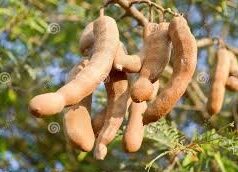Food as Health THE TAMARIND

Tamarind (Tamarindus indica) is of the leguminous tree family. It grows in the wild, nonetheless native to tropical Africa. However, because of cultivation, it can be found in almost every part of the globe. Though it was introduced to the Americas by Spanish and Portuguese explorers in the 16th century, it has since formed part of the main component for most of their foods.
There are many species of the Tamarind some of which are, Tamarindus Indica, African velvet Tamarind (Dialium guineense) and the Manila tamarind, Madras thorn, or camachile also known as Pithecellobium dulce. Whereastheabovethree speciesproduce similar fleshy, tangy sweet tasting fruits and can literarily be put to similar culinary and medicinal uses, they do not present alike. The Tamarindus Indica and the Manila Tamarind are closer in presentation with leguminous oblong pods while the Velvet Tamarind has small roundish hard black coating.
The Tamarind indica is called by different names in different locales where it is found. For instance, most Latin American countries like Columbia, Honduras, Peru, Venezuela and even Spain (where it used for drinks), call it Tamarindo. In the Caribbean it is called Tamon, Indonesia and environs call it Asam jawa, Philippines calls it Sampalok, in Timor it is called sukaer.
Back home in Africa we have both the Indica and the African velvet species where they mainly grow in the wild. Whereas the Indica is found mostly in the Sahel region of Africa, in places like Niger, The Gambia, Chad, Senegal, Northern parts of Sudan, Cameroon, and Nigeria, the African velvet is found in tropical rain forest of the West African Sub region in countries like Nigeria, Ghana, Togo, Sierra Leone to mention but a few. It is called Tsamiyar kurm in Hausa, Icheku or chichiba. in Igbo and Awin in Yoruba. It is also called atchethewh in Togo, Yoyi in Ghana, black Tombia in Sierra Leone, Veludo in Guinea Bissau and Senegal.
Though both species make delicious beverages and snacks among others, it appears the black velvet is more readily available and appeals more to people because of its eat- on-the-go nature. Many people cannot resist the temptation of stopping by the roadside to buy it from fruit vendors to be popping into their mouths on the go.
However, the truth of the matter is that both are highly medicinal and have been used for years both as food and as home remedy for certain ailments.
For instance, both can be eaten as snacks, can be soaked, and pulped as beverage and can be added to smoothies and locally made drinks like kunu aya and kunu jata. They are said to be very rich in ascorbic acid and as such serve as antioxidant, boosts immunity and as good remedy for most vitamin c deficient induced conditions like scurvy, anemia, dry damaged skin, and slow healing.
They are also claimed to aid healthy heart conditions because of the presence offlavonoid which “lowers LDL or “bad” cholesterol and raise HDL or “good” cholesterol levels, thus preventing the build-up of triglycerides (a type of fat) in the blood. It also has high potassium content which can help keep your blood pressure in check”.
The Indica has been particularly proved to be of great help as a general cleanser especially after consumption of a lot of meat during festive periods. Mothers are known to have them soaked in plain water, whole pod and seed shortly before the start of festivities, to be administered to the family every morning as detox and anti-constipation after the heavy feeding that follows celebrations. It has been documented that the fruit has laxative effects due to its high quantities of malic acid, tartaric acid and potassium bitartrate, it can effectively relief constipation
The wood and leaves of both species are also said to be of good use for edible and therapeutic purposes. Children snack on the baby leaves in the wild as part of their escapades on their way to the stream and fetching firewood, while in some other cultures, both the fruit and the leaves are used as poultice applied to the forehead to treat fever.
In the conclusion of his on the paper, “Analytical and Nutritional Evaluation of Velvet Tamarind (Dialium guineense) Pulps”, presented to the Department of Chemistry, Ekiti State University, Ogungbenle Henry Niyi stated that “The results showed that velvet tamarind would provide essential valuable minerals needed for body growth, low levels of anti-nutrients, high vitamin c content and energy value for body metabolism. The data suggest that the sample is nutritionally good for children, adult and also may supply some nutrition deficiencies”
The findings and conclusion of the paper are eloquent testimonies to that fact that Tamarind is not just food, but also has medicinal values that can keep the doctor away, so next time when you see food vendors with either Tamarind indica or black velvet, don’t forget to stop and get some for you and the family.
However, notwithstanding the huge benefits of tamarind, it is advisable to stay on the safe side, consume in
moderation.


BLACK VELVET TAMARIND((Dialium guineense)


TAMARIND (TAMARINDUS INDICA)


MANILA TAMARIND (Pithecellobium dulce)
LOCAL NAMES FOR TAMARIND
Igbo: Icheku or chichiba
Hausa: Tsamiyar kurm
Yoruba: Awin
Togo: atchethewh
Ghana: Yoyi
Sierra Leone: black Tombia
Guinea Bissau and Senegal: Veludo
Latin America: Tamarindo
The Caribbean: Tamon
Indonesia and environs: Asam Jawa
Philippines: Sampalok
USES
Beverage
Snacks
Rich source of Vit C
Anti-oxidants
Immune boosters
Detoxifier

